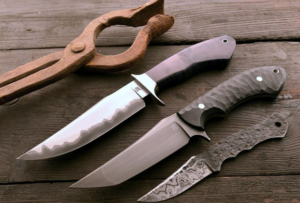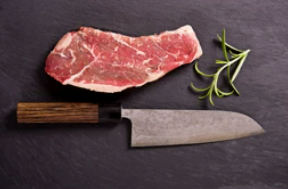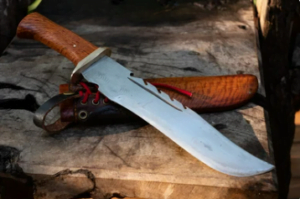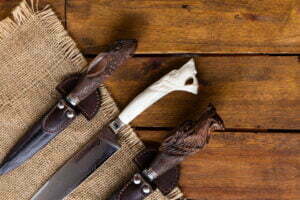How many types of Knives are there?
The world of knives is wide and rich, but one can get a little lost in it from time to time
So, to make sure that you are well informed when it gets to choosing your next knife, we leave you this brief guide of types of knives

Tactical, Combat, Chef. We can think of these large groups to better understand the range of types of knives.
And the handmade knives that we provide? Oh, they are versatile, practical and works of art, but in what group do we get them in? Let’s see where they fall into in this categorization of types of knives.
Chef’s Knife
The most popular kitchen knife is the “Onion Knife” or “Chef’s knife”. As it’s name recals it, it’s used in kitchens, from making a home-made meal to a top-tier restaurant. Versatile in use, it’s ideal for chopping vegetables and aromatics, chopping meat and fish, and a number of more general uses the situations could present. The Chef’s Knife also has place in pastry, for the prepare of desserts or the cutting of cakes.
They have a wide blade, with a straight spine and a slightly curved edge that ends in a pointy tip. It usually measures between 5.51″ (14 cm) and 7.87″ (20 cm), although they can measure up to 11.8″ (30 cm). The curve facilitates cutting and allows you to execute the knife’s signature rocking motion, also contributing the knife to feel an extension of the chef’s body.

The model kitchen knife is the Santoku, typical of Japanese chefs. The word “santoku” can literally be translated to English to mean “three virtues” or “three uses”. What are these? Chopping, Dicing and Mincing. They’ve became very popular among chefs all around the world for it’s balanced design making it easier to work with, as if it was an extention of one’s hand.
The shape of the Santoku blade is very characteristic as it has a flat base, a rounded tip and a length of between 4.72″ (12 cm) and 7.87″ (20 cm).
In any kitchen, a Santoku it’s an intelligent move, and a distinguid signature.
Tactical Knife
The Tactical Knife, also known as “Military Knife”, is used as a survival tool, capable ant thought for fulfilling multiple functions. They are usually used by army special forces and police around the world, but their use has spread to hunting enthusiasts, hikers and nature lovers or adventurers, due to their high quality and versatility. Because they are generalist tools, tactical knives have a huge variety of models, styles, and sizes.

The tactical knife for excelence is the KA-BAR. The KA-BAR knife, first MK1 model then MK2, It’s famous as it was used by the US Marine Corps (USMC) in World War II. It was thought for covering different uses, from opening a can to cutting a rope, and later used in combat.
What’s with the name? Well, the most accepted version of the name origin, is that of a letter received by the company of a fur trapper. The man, when attacked by a bear, grabbed the knife to defend himself against the animal. The only thing that was legible on said letter was a letter K and the word “bar”, which was mean to meant “kill a bear”. Thus, the company Union Cutlery Co changed the name of the knife to KA-BAR as trademark.
The KA-BAR knife features a straight blade with a slightly curved tip. It’s between 3.93″ (10 cm) and 7.87″ (20 cm) long (much less than the Bowie) and has a width of 1.18″ (3 cm) in carbon steel.
We say “Combat” and not “Tactical” so, first, what’s the difference between them?
Knives are created with and for a purpose beforehand. They are thought and designed to fulfill a particular function. Therefore, it’s important to know the characteristics of each one to acquire a knife that works for you.
The difference is simple:
A tactical knife is designed for versatile functions that can arise in different situations, such as survival or camping in the wilderness. For its part, the combat knife is simply for hand-to-hand combat.
Combat Knife

And when it gets to Combat Knife, the best known and loved of these is the Bowie Knife, a hunter’s classic now-a-days. It has a fine, straight blade, but with a more pronounced raised point than a KA-BAR. It has a length of between 3.93″ (10 cm) and 11.8″ (30 cm).
It’s a combat knife with a lot of history in it’s blade. Back then, in the 19th century, hunting knives wheren’t as fine as they are today. The Bowie Knife was one of the firsts to have a great blade and a good finish, usually in silver.
It was created by Jim Bowie and perfectionated in it’s forge by the blacksmith James Black. Jim used this knife to defend himself against three men who wanted to kill him, and after that, he continued to use it for each of his fights. This moment is known as the Sandbar Fight, and it launched on Bowie’s popularity, giving it a reputation that’s still in vogue today.
Argentinian Steak Knife
Our handmade knives are inspired by the knives of the Argentine Gaucho.

What’s a Gaucho?. It’s the name given to the habitants of the rural plains and adjacent areas of Argentina in the 16th century. They were known for being skilled horsemans, hunters and connoisseurs of
cow cattle plow. The Gauchos had a pseudo nomadic style, and embodied the values of freedom, honor, and bravery. They belonged nowhere and responded to noman.
They believed that nature would provide anything they needed, and all they had to do was embrace the habilities to harness from it. In their travels and peripecys, they becamed skilled in all types of surviving techniques. That’s the reason why they took their knife anywhere they go. With time, it became part of their traditional clothing, perduring over time and staying imprinted as a symbol in culture.
Gauchos used their knives for hunting and work, as well as for hand-to-hand combat. And when it got to meal time, they didn’t leave them behind, as they used it also for Asado. We can think of an Asado as a Barbecue, but made the way it’s name says: “roasted”. Gauchos used to make Asado with the animals they hunted, a fire made with their own hands implementing wood and coal, and a sharped resistent knife to prepare and eat the meal.
For this reason, our artisan knives have a defined propose, but are mainly versatile and resistant.
On the other hand, our knives are also a work of art. Gauchos used to handcraft their equipment, so we choose to stay true to this premise and work with artisains all over the country to make the finests handcrafted knives.
Knives forged the Pampa’s Way
Now a days, we inspire in the Gaucho tradition of Asado to make our knives. We believe that the moment of cooking and lighting a fire brings people together, creating a significant and unvaluable moment made possible by the hand of the “asador” and its knife.
The purpose of our handcrafted knives is for you to use them for cooking, both in the kitchen and outdoors, that is why they are chosen for day-to-day use and for camping. They’re one of those knives you’d like to have in your pack, and that’ll became indispensable.

They have a blade with a straight spine, a curved edge and a slightly rounded tip. Made of 420 Stainless Steel or Damascus Steel (ss316 and vg10 stainless steel). Measures between 5.51″ (14 cm) and 11.8″ (30 cm). Compared to others, this steel has a high resistance to oxidation, good traction and exceptional firmness. This allows intensive use without high risk of wear or breakage.
So, where can we place the handmade steak knives that we provide? We can think that our artisan knives are between a Santoku for its purpose, and a KA-BAR for the type of blade. They are perfect for cooking, making them the dream complement and friend for a Bowie.
We only use the best material our land has to offer. This reflects into unique handmade products. Our products are crafted with the philosophy of the Gaucho Culture, bringing to the present its values, art and way of co-existing with the countryside. And so, we work with artisans throughout the country, fomenting the local Argentine economy.
Now that you know more about knives than before, why not take a look at our offer?
We know that picking a knife is more than doing a purchase. It’s a personal choice, one that we do following our instincts and necesities, contemplating what are we going to need it for and what other knives we have it’s going to coomplement. We invite you to take a look at everything we have to offer you in terms of Steak Knives, Nickel Silver, Carved and our special Damascus Steel Knives.
1 reply on “How many types of Knives are there?”